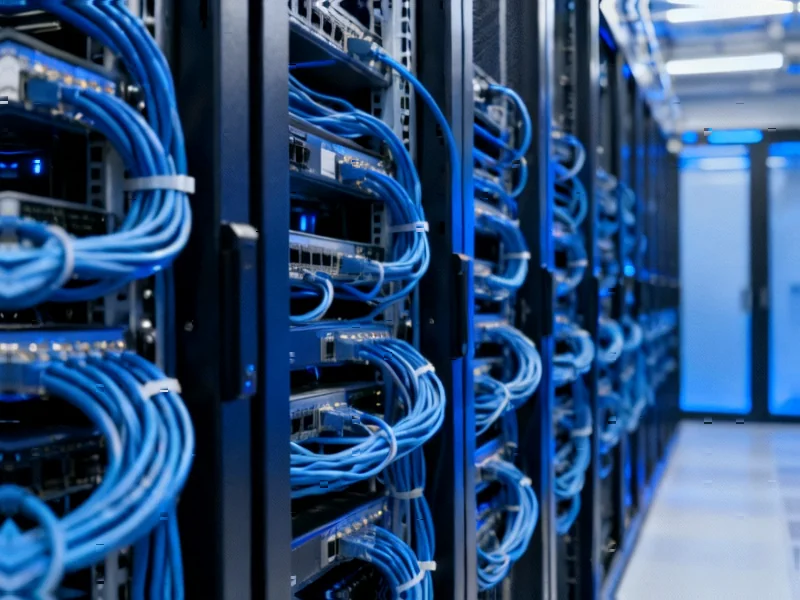According to DCD, CleanArc Data Centers CEO Jim Trout is building his third major digital infrastructure company after previously founding CoreSite and launching Vantage Data Centers. The industry veteran secured funding from Nuveen, the investment manager for TIAA with $1.3 trillion in assets under management, though the specific investment amount wasn’t disclosed. CleanArc’s first campus in Virginia’s Caroline County will eventually offer 600MW of capacity, with 200MW coming online by Q2 2026 and another 300MW by mid-2027. The company has secured expressions of interest for 3GW of clean power and is working with two hyperscale clients on technical due diligence for AI-ready infrastructure.
Table of Contents
- The Serial Founder’s Edge in Hyperscale Development
- The Renewable Energy Imperative in AI Infrastructure
- Virginia’s Data Center Dominance Faces Challenges
- Institutional Capital’s Growing Appetite for Digital Infrastructure
- The AI Infrastructure Arms Race Demands Unprecedented Flexibility
- Navigating an Increasingly Crowded Competitive Field
- The Enterprise AI Opportunity Beyond Hyperscale
- Related Articles You May Find Interesting
The Serial Founder’s Edge in Hyperscale Development
Jim Trout’s career trajectory represents something rare in the data center industry – a founder who has successfully built multiple major platforms from scratch. His experience spans the entire evolution of modern digital infrastructure, from the carrier hotel era at One Wilshire to today’s AI-driven hyperscale computing demands. This institutional knowledge provides CleanArc with advantages that newer entrants lack: established relationships with power providers, familiarity with regulatory processes across multiple markets, and credibility with both investors and hyperscale customers who value proven execution capability.
The Renewable Energy Imperative in AI Infrastructure
CleanArc’s focus on pre-negotiated renewable energy agreements reflects a fundamental shift in hyperscale requirements. As AI workloads dramatically increase power consumption – with some estimates suggesting data center energy demand could double by 2026 – sustainability has moved from marketing differentiator to operational necessity. Major cloud providers face increasing pressure from shareholders, regulators, and customers to meet ambitious carbon reduction targets. By securing 3GW of clean power expressions before breaking ground, CleanArc is addressing what has become the primary constraint in hyperscale development: reliable, sustainable energy capacity rather than physical real estate.
Virginia’s Data Center Dominance Faces Challenges
The choice of Virginia for CleanArc’s flagship campus leverages existing infrastructure and talent pools, but also highlights the concentration risk in primary data center markets. Northern Virginia has become the world’s largest data center hub, representing over 50% of the U.S. market, creating significant strain on local power grids and transmission infrastructure. CleanArc’s Caroline County location offers proximity to this ecosystem while potentially benefiting from less congested interconnection points. However, the industry-wide rush to secure positions in established markets creates competitive pressures for skilled labor, construction resources, and timely utility upgrades that could impact development schedules.
Institutional Capital’s Growing Appetite for Digital Infrastructure
The participation of Nuveen and other institutional investors signals maturing recognition of data centers as core infrastructure assets. Pension funds and insurance companies traditionally favored transportation, energy, and utilities, but are increasingly allocating to digital infrastructure as cloud adoption and AI drive predictable, long-term revenue streams. This capital influx comes with heightened expectations for environmental, social, and governance standards, which aligns with CleanArc’s renewable energy focus. However, it also introduces potential tension between the patient capital requirements of infrastructure development and quarterly performance pressures faced by asset managers.
The AI Infrastructure Arms Race Demands Unprecedented Flexibility
Trout’s emphasis on technological flexibility to accommodate future Nvidia designs and varying CPU/GPU configurations highlights a critical challenge in AI-era data center planning. The rapid pace of processor innovation means facilities designed today must accommodate power densities and cooling requirements for hardware that doesn’t yet exist. This requires overbuilding electrical infrastructure, implementing liquid cooling capabilities before they’re immediately needed, and designing for modular expansion that can respond to unpredictable demand patterns. The companies that succeed will be those that balance current efficiency with future-proofing for unknown technical requirements.
Navigating an Increasingly Crowded Competitive Field
CleanArc enters a market where established players like Digital Realty and Equinix are accelerating their own sustainability initiatives while specialized AI infrastructure providers emerge almost monthly. The company’s differentiation through pre-packaged renewable energy solutions addresses a genuine market need, but execution risk remains substantial. Success will depend not just on securing power and land, but on delivering projects on schedule amid supply chain constraints, navigating complex interconnection queues, and maintaining the financial discipline to avoid the over-leverage that has troubled some digital infrastructure developers during previous growth cycles.
The Enterprise AI Opportunity Beyond Hyperscale
Trout’s mention of exploring 25-50MW facilities for Fortune 100 companies reveals a strategic diversification beyond pure hyperscale development. Many large enterprises are building dedicated AI capabilities but lack the scale or expertise to develop their own infrastructure. This middle market represents a significant opportunity as companies seek to maintain control over proprietary data and models while accessing enterprise-grade computing resources. However, serving this segment requires different commercial models, security protocols, and support structures than the wholesale arrangements preferred by cloud providers, presenting both challenge and opportunity for platform builders like CleanArc.



